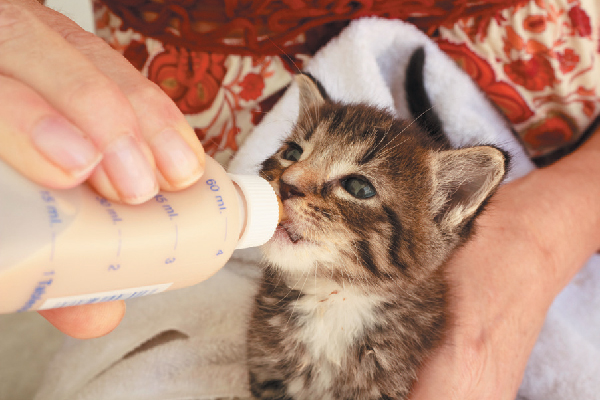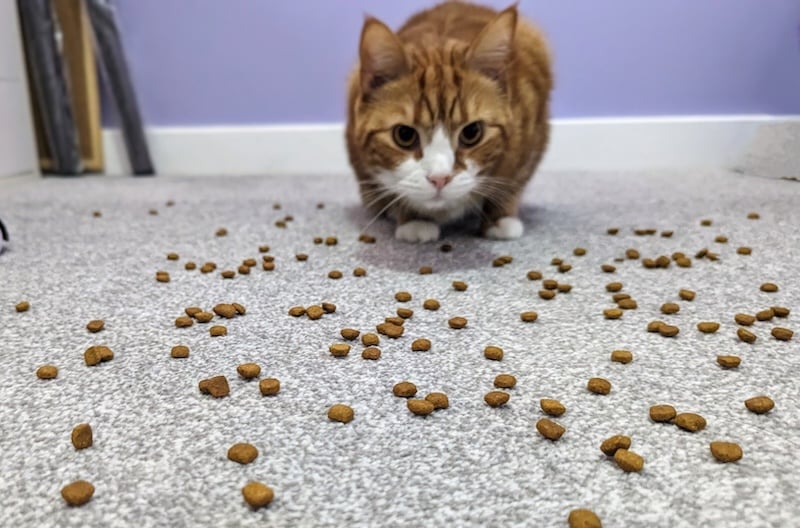Wondering what to feed kittens? A kitten, on average, weighs just a few ounces at birth and reaches 8 to 10 pounds — or more — by his first birthday. When I adopted Casey, my orange tabby, he weighed barely 4 pounds at 4 months old. Eight months later, he transformed into a long-legged, lean feline sporting 11 pounds of solid muscle.
I promised to keep Casey from morphing into a fat cat who walks with more waddle than wiggle. And you can do the same for the new kitten in your life. Every extra pound your feline friend packs on escalates the odds of him being at risk for a host of pricey problems: obesity, diabetes and, eventually, joint pain and arthritis. How can you keep your fast-growing kitten from turning into a feline foodie? What is the best food to feed your kitten? For answers on what to feed kittens, I turned to one of the country’s top kitten experts: Gary Weitzman, DVM, a veterinarian and chief executive officer of the San Diego Humane Society and SPCA — the same shelter where I adopted Casey.
Each year, Dr. Weitzman oversees a dedicated staff and army of volunteers who feed more than 2,000 orphaned kittens. These are not-yet-weaned kittens, separated from their moms for a variety of reasons, who must depend on round-the-clock feedings to not only survive but thrive and be healthy enough to be adopted. Dr. Weitzman is also the author of the best-selling book, How to Speak Cat: A Guide to Decoding Cat Language. Here are his answers to some common questions when it comes to what to feed kittens:
Question: Why is it vital to feed a newly adopted kitten quality commercial food manufactured specifically for a feline under the age of 1?

Answer: Just like any young animal, kittens need vital nutrients to ensure they develop appropriately. Kitten food generally has higher protein for muscle development, extra lysine for vision, and other vitamins and minerals needed for healthy growth.
Q: Should a kitten be fed both canned and wet food?
A: At our kitten nursery, we feed underage kittens formula, which closely mimics milk they would normally get from their mother. At 3 1/2 weeks of age, we introduce wet and dry food, but wet food is often more palatable for young kittens, making it easier for them to get adequate nutrition as they develop.
Q: What’s going on inside a growing kitten in terms of growth and caloric needs?
A: Keeping body temperatures up is critical, so growing kittens need additional calories for proper development. Their organs are developing, their muscles are becoming stronger and more coordinated, and they tend to be much more active than adult cats. That is why it is vital that they get proper nutrition and calories to ensure they grow into a healthy and happy adult cat.
Q: How can I prevent my kitten from becoming obsessed with food and becoming overweight?
A: To keep your kitten from morphing into a feline foodie, we recommend against free feeding. Kittens 8 weeks or older should be fed two to three times daily (multiple small meals are best) in controlled amounts. Measure the food out at each meal, and weigh your cat once weekly to gauge development and prevent obesity.
Q: Is it safe to occasionally provide a meal inside a food puzzle rather than in a bowl for a young kitten?
A: Food puzzles are always a great way for pets to stay entertained and develop those little brains! Using puzzle feeders encourages kittens to use all their senses. If you notice your kitten can’t quite figure it out, and you’re worried he isn’t getting enough to eat, you can offer him his food in a bowl, and keep the puzzle feeder for enrichment.
Dr. Weitzman’s tips on how to bottle-feed very young kittens

- Kittens are very cold sensitive. To bottle-feed a young kitten, be sure he is warm before you feed him; a cold kitten cannot digest food properly.
- He should be lying prone (on his stomach).
- Use warm formula (not too hot, not too cold).
- Talk to your vet, and follow the directions on the formula packaging for how often and how much to feed.
- Cup and gently rub the kitten’s cheeks to encourage him to latch. Once you get a good latch, his ears often start to twitch, and you’ll see bubbles in the bottle.
- Feeding a kitten alongside a buddy is a good way to encourage competition for the nipple, which also encourages them to latch because kittens with a mom often compete for the same nipple.
Tell us: What other questions do you have when it comes to what to feed kittens?
Featured Image Credit: Fayzulin Serg, Shutterstock
Read more about kittens on Catster.com:
- How Much to Feed a Kitten
- Kittens Meowing — How and Why Baby Cats Meow
- Can Kittens Drink Cow’s Milk?
- 1 Question: Why is it vital to feed a newly adopted kitten quality commercial food manufactured specifically for a feline under the age of 1?
- 2 Q: Should a kitten be fed both canned and wet food?
- 3 Q: What’s going on inside a growing kitten in terms of growth and caloric needs?
- 4 Q: How can I prevent my kitten from becoming obsessed with food and becoming overweight?
- 5 Q: Is it safe to occasionally provide a meal inside a food puzzle rather than in a bowl for a young kitten?
- 6 Dr. Weitzman’s tips on how to bottle-feed very young kittens





